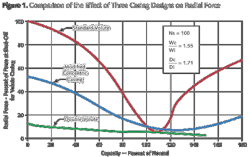Activated Magnetic Bearing Potential for Centrifugal Pumps
By Allan R. Budris
I trust that many of my readers have seen the recent New York Times article entitled "Bearings That Pack a Punch (and Their Own Controls)", about a new development in "Activated Magnetic Bearings" (AMB) which could have advantages for centrifugal pumps. The article was fairly upbeat on the future of these bearings in industrial systems, based on the cost and space savings from this recent development, in addition to the existing advantages that magnetic bearings offer, such as energy savings from very low friction, no bearing wear, higher allowable speeds, elimination of the need for complex lubrication systems, less maintenance, built in vibration / fault detection, and longer life.
How exactly do they work? Activated magnetic bearings use electromagnetic coils to levitate rotating shafts. Sensors monitor the shaft's position and then feed that information to a digital controller. The controller changes the electrical current in the coils to adjust electromagnetic forces on the shaft, based on computer algorithms that keep it centered and balanced. These actions happen very quickly (thousands of times a second), precisely maintaining the shaft position, even at high speeds. No metal-to-metal contact means that magnetic bearing systems generate less friction (less energy consumption), without lubrication. Instead, the shaft is suspended in the surrounding medium, which could be air or a liquid.
Bearing Cost Comparison
Despite all of the above advantages, magnetic bearings have been slow to widely catch on, especially with industrial and municipal pumps. Primary reasons have been the complexity and high associated cost of these systems. Magnetic bearings could cost about $45,000 more than an oil-lubricated hydrodynamic bearing system on a large industrial pump. This relative AMB cost disadvantage is even larger when compared to the initial cost of a simple ball bearing system, in say a small pump. The cost difference is not because of the AMB bearing hardware (which are electromagnetic coils that can be wound as economically as motor stators, which are fairly inexpensive). The control system is to blame, which includes the cost of a sophisticated digital controller, sensors to monitor shaft position, cables to carry shaft-position data to the controller, and cables to move power from the controller's amplifier to the electromagnetic coils (the last two items not being required for the new integral control magnetic bearing development described in reference #1).
But initial coast should not be the only consideration. As pointed out in the author's December 2009 WaterWorld "Life Cycle Cost" column, Best-of-Class pump users do not buy or upgrade pumps based solely on initial cost, but instead also consider such other costs as energy, maintenance (including lubricant and filter purchase / handling), spare parts, operational down time, and rebuilding costs. Bearings are the second most susceptible component to fail in a centrifugal pump, after mechanical shaft seals. When these other costs are considered, magnetic bearing can become more attractive.
Maintenance, Reliability
Magnetic bearing controllers do have a finite life. The mean time until controller failure is about eight to 15 years, depending on how hard the electronics are pushed. The actual magnetic bearings, like an electric motor, should last about 20 to 30 years, depending on the environment and how fast the insulation breaks down.
In addition, the air filters on the controller cooling system must be changed regularly, and the monitoring output should be checked to insure proper bearing internal clearances (air gap between the shaft and coils) and machine vibration. This function is particularly useful on critical machines. By monitoring potential problems, these intelligent bearing systems can alert operators to threatening failures before they occur.
Load Limitations
Rolling (antifriction) bearings in pumps can usually handle temporary overload conditions, and although steady-state overloading may shorten ball bearing life, in most cases the pump will survive, at least for the short term.
On the other hand, magnetic bearings are not forgiving of overload. They have a specific load-carrying capacity. A pump equipped with an active magnetic bearing system that is undersized for the load will not function. If the electromagnets are unable to support the shaft weight plus the impeller unbalanced pressure forces, the shaft will no longer be levitated and the machine will shut down. For this reason, the actual pump bearing loads, both static and dynamic, must be accurately known.
Figure 1 shows how the unbalanced static pressure radial forces on the impeller vary with pump relative flow rate. As can be seen, pumps which use a volute casing (the most common) generate high radial loads at very high and very low flow rates. The author remembers a problem with an early magnetic bearing research effort at Worthington Pump, when it turned out that the actual prototype pump radial loads were twice as high as originally believed, which caused the AMB's to not function during the initial test. However, the radial load measurements obtained during the initial test guided the selection of higher rated alternate magnetic bearings, which did function properly. The lesson here is that even the pump vendor may not know the actual pump radial and axial loads.
In addition, pumps are also subject to dynamic loads, from: rotor unbalance (which in the case of a sewage pump could also be impacted by the solids handled); pressure pulsations from the interaction between the impeller vane exit suction and discharge pressures and the casing (volute) tongue cutwater; cavitation forces; and any system generated water-hammer pressure waves. Also, magnetic bearings do not provide any damping, which could be important in some complex vibrations situations. Therefore, magnetic bearings should be selected with some safety margin to account for such dynamic forces. Because of these pump load uncertainties and the possibility of power or control system failure, magnetic bearings typically require some kind of back-up bearing system. Therefore, due the above potential load uncertainties, it is also recommended that some time be spent prototyping applications with magnetic bearings. Fortunately, this design effort is made easier by the magnetic bearing capability of self-measurement of the shaft forces, as in the Worthington case.
Applications
Magnetic bearings are most attractive to high speed machines (such as turbines, compressors, vacuum pumps and motors), and for super clean environments (such as found in the semiconductor, biotech and cryogenic industries), which are where most magnetic bearings are used today.
Although there are also advantages for centrifugal pump applications, such as high reliability, energy savings, and the ability to monitor and diagnose pump vibration (which can detect pending pump faults). As a result, activated magnetic bearings are beginning to be applied to some pump applications, such as for a 610 hp, 3580 rpm, multistage boiler feedwater pump in an electric generating station, and a 800 hp, 1780 rpm, single stage process pump installed in a natural gas pipe line.
Conclusions
So where does this leave water and wastewater pump users? Well, for most W/WW applications, the current high initial cost and complexity of magnetic bearings cannot be justified. Also, the risk-to-reward ratio is probably too high for wastewater applications which handle solids that can generate high dynamic bearing loads.
However, it is probably worth at least investigating the use of activated magnetic bearings on large, critical water pump applications (which use hydrodynamic bearings with an external oil lubricating system), especially those which have experienced poor bearing reliability, and/or vibration problems. Also, the cost of magnetic bearings is bound to become more affordable over time with future standardization, the continued decline of electronics costs, and such new developments as Synchrony Integral Control's Fusion magnetic bearings.
References:
- Anne Eisenberg, "Novelties: Bearings That Pack a Punch (and Their Own Controls", The New Your Times, January 2, 2010.
- Todd W. Reitsma, "Lift Off Friction", SKF Magnetic Bearings Calgary, Canada, Sept. 1, 2006.
- "Centrifugal Pump With Magnetic Bearing", Pump, Valve and Heat Exchanger Blog, January 28, 2009.
More WaterWorld Current Issue Articles
More WaterWorld Archives Issue Articles




